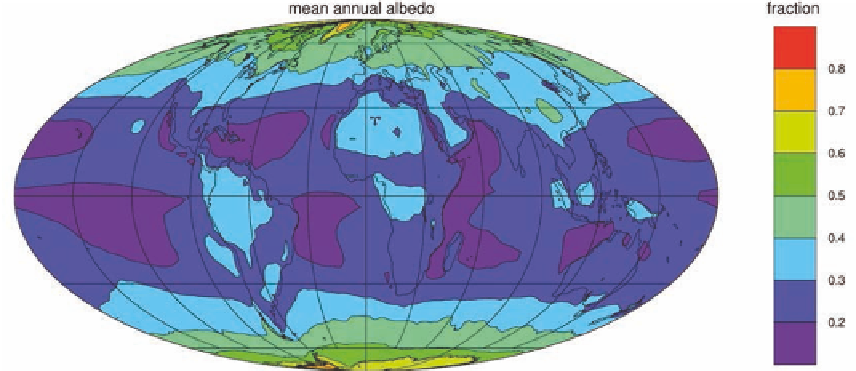Geoscience Reference
In-Depth Information
Figure 4.19 Variation of
surface albedo.
In gener-
al, albedo values are higher
on brighter surfaces than on
darker ones.
Snow, 80%-95%
Concrete, city streets, 5% -15%
Crops, fields,
10%-25%
Forest,
10%-20%
Lakes, oceans,
5% - 65% (depends
on Sun angle)
Grass, 25%-30%
Dark roof, 10%-15%
Blacktop highway,
5%-10%
When the Sun is directly overhead, water has an albedo
value of around 5%, but when the Sun is near the horizon, the
albedo value is around 65% because radiation reflects off of
the surface more readily. You can see this difference clearly in
Figure 4.20, which shows that oceans at higher latitudes have a
higher albedo than those at lower latitudes. This variability oc-
curs because the angle of incidence is smaller at higher latitudes
and more radiation is reflected off the oceans in those regions.
The Angle of Incidence
With the concept of solar radiation and Earth interactions
in mind, you can further explore this important concept by
viewing the simulation
The Angle of Incidence
. This simula-
tion allows you to interact with the angle of incidence as it
relates to latitude. The foundation of this simulation is Figure
3.3, which shows how the angle of incidence influences how
much solar radiation is received at any given location. You will
be able to choose between several latitude locations in the
Northern and Southern Hemispheres to see how the angle of
incidence varies between locations. As you work through the
various scenarios, notice not only how the flow of solar radia-
tion changes, but also the direction from which it comes. You
should observe a big difference between the Northern and
Southern Hemispheres. Pay attention to these differences and
relate them back to what you have learned about Earth-Sun
geometry and seasons.
Figure 4.20 mean annual
albedo across the Earth's
surface.
The bar code at
the right represents percent-
age albedo. Blue areas indi-
cate zones of relatively low
albedo and are concentrated
in the oceans where radia-
tion is absorbed. Polar ice
caps, in contrast, have rela-
tively high albedo, almost as
much as 70%.








































